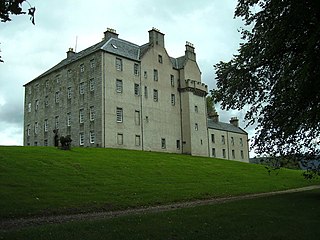Related Research Articles

Castle Grant stands a mile north of Grantown-on-Spey and was the former seat of the Clan Grant chiefs of Strathspey in Highlands, Scotland. It was originally named Freuchie Castle but was renamed Grant in 1694. The castle is a Category A listed building and the grounds are included in the Inventory of Gardens and Designed Landscapes in Scotland.
Janet Beaton, Lady of Branxholme and Buccleugh (1519–1569) was an aristocratic Scottish woman and a mistress of James Hepburn, Earl of Bothwell. She had a total of five husbands. One of her nieces was Mary Beaton, one of the four ladies-in-waiting of Mary, Queen of Scots, known in history as the four Marys. In her lifetime, she was accused of having been a witch. Janet was immortalised as Sir Walter Scott's Wizard Lady of Branxholm in his celebrated narrative poem "Lay of the Last Minstrel".

Agnes Leslie, Countess of Morton was a Scottish noblewoman, being the daughter of George Leslie, 4th Earl of Rothes as well as a great-granddaughter of King James II. She was the wife of William Douglas, 6th Earl of Morton, who as Laird of Lochleven Castle was the custodian of Mary, Queen of Scots during her captivity from June 1567 until her escape on 2 May 1568. Agnes was Queen Mary's chief female companion throughout her imprisonment; thus it was while Lady Agnes was recovering from childbirth that the queen successfully escaped from Lochleven.

Hugh Fraser, 5th Lord Lovat was a Scottish landowner.
John Stewart, 3rd Earl of Atholl (1507–1542) was the son of John Stewart, 2nd Earl of Atholl and Lady Janet Campbell, a daughter of Archibald Campbell, 2nd Earl of Argyll and Elizabeth Stewart.
Lady Lilias Grant was a Scottish letter-writer and matriarch of the Grant clan of Freuchie.
Janet Fockart was a Scottish merchant and moneylender.
John Grant of Freuchie was a Scottish landowner.

Alexander Elphinstone, 4th Lord Elphinstone (1552-1638), was a Scottish courtier, landowner, and Lord Treasurer.

Robert Elphinstone, 3rd Lord Elphinstone (1530-1602) was a Scottish landowner and courtier.
Patrick Drummond, 3rd Lord Drummond (1550–1600) was a Scottish landowner.
Thomas Kerr of Ferniehirst was a Scottish landowner, Roman Catholic and supporter of Mary, Queen of Scots. He and Jean Scott ended the feud between the Scott family and the Kerrs. Thomas and Jean were both involved with supporting Mary, Queen of Scots.
Malcolm Beg Mackintosh was the tenth chief of the Clan Mackintosh, a Scottish clan of the Scottish Highlands. He was also chief of the confederation of clans known as the Clan Chattan.
Janet or Jean Scott, Lady Ferniehirst was a Scottish landowner. She was a member of the Border family of Scott who succumbed to an arranged marriage that healed the feud with the family who killed her father. Her marriage to Thomas Kerr of Ferniehirst was successful and she took a role in Scottish politics between the Scottish court and the exiled Mary, Queen of Scots.
Elizabeth Barlay or Barlow was an English lady in waiting to Margaret Tudor the wife of James IV of Scotland.
John Forbes, 6th Lord Forbes was a Scottish landowner.
Janet Stewart was a Scottish aristocrat.

James Grant, 7th of Freuchie (1616–1663) was a Scottish landowner, the seventh Laird of Freuchie. He was the 18th Chief of Clan Grant.

John Grant of Freuchie (1596-1637) was a Scottish landowner.

Ludovick Grant, 1st of Grant and 8th of Freuchie (1641–1717) was a Scottish politician and soldier. He was the 19th Chief of Clan Grant and referred to as the "Highland King."
References
- ↑ Fraser, William (1883). Histories of Scottish Families: Chiefs of Grant. Vol. 1: Memoirs. Edinburgh: W. Fraser. OCLC 1292538501 – via National Library of Scotland.
- ↑ William Fraser, The chiefs of Grant: Memoirs, vol. 1 (Edinburgh, 1883). p. 126.
- ↑ William Fraser, The chiefs of Grant: Memoirs, vol. 1 (Edinburgh, 1883). p. 145: William Mackay, Fraser Chronicles (Edinburgh, 1905), p. 165.
- ↑ William Fraser, The chiefs of Grant: Memoirs, vol. 1 (Edinburgh, 1883). pp. 127, 145: National Records of Scotland, E30/11 f2v, account of George Wishart of Drymme.
- ↑ William Fraser, The chiefs of Grant: Memoirs, vol. 1 (Edinburgh, 1883). p. 152 and plate.
- ↑ William Fraser, The chiefs of Grant: Memoirs, vol. 1 (Edinburgh, 1883), pp. 153-5.
- ↑ William Fraser, The chiefs of Grant: Memoirs, vol. 1 (Edinburgh, 1883), pp. 153-4.
- ↑ William Fraser, The chiefs of Grant: Memoirs, vol. 1 (Edinburgh, 1883). pp. 150-1.
- ↑ William Fraser, The chiefs of Grant: Memoirs, vol. 1 (Edinburgh, 1883), p. 153.